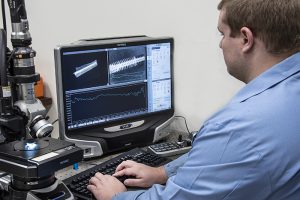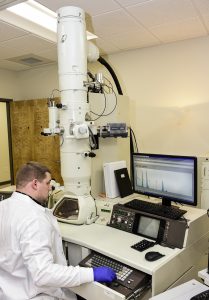The Microscopy Laboratory at MCLinc is equipped with a variety of highly specialized instruments to accommodate characterization on a vast diversity of samples.

- Optical Microscopes: phase contrast, polarized light
- Electron Microscopes
Three scanning electron microscopes (SEM) and one transmission electron microscope (TEM) provide ultra high-resolution microscopy (magnification to 1,000,000x) to identify extremely small particles. All are equipped with energy dispersive x-ray spectroscopy (EDS) to provide elemental analysis.

Energy dispersive spectroscopy (EDS) measures the number of x-rays produced by a solid sample when irradiated by electrons versus the energy of these x-rays. The EDS technique identifies and quantifies the element constituents of the sample.
Scanning electron microscopy (SEM) is a method for high resolution surface imaging. The advantages of SEM over light microscopy include greater magnification (up to 100,000X) and much greater depth of field. Different elements and surface topography emit different amounts of electrons, yielding an electron micrograph in which the contrast is representative of surface topography and composition. The SEMs are equipped with EDS to provide elemental analysis.
Transmission Electron Microscope (TEM) requires thin samples, typically 100 nm or less, that can transmit most of the incident electrons. TEMs offer a resolution of 0.8 to 1 A, an order of magnitude better than the resolution of SEMs. The TEM is equipped with EDS to provide elemental analysis.
